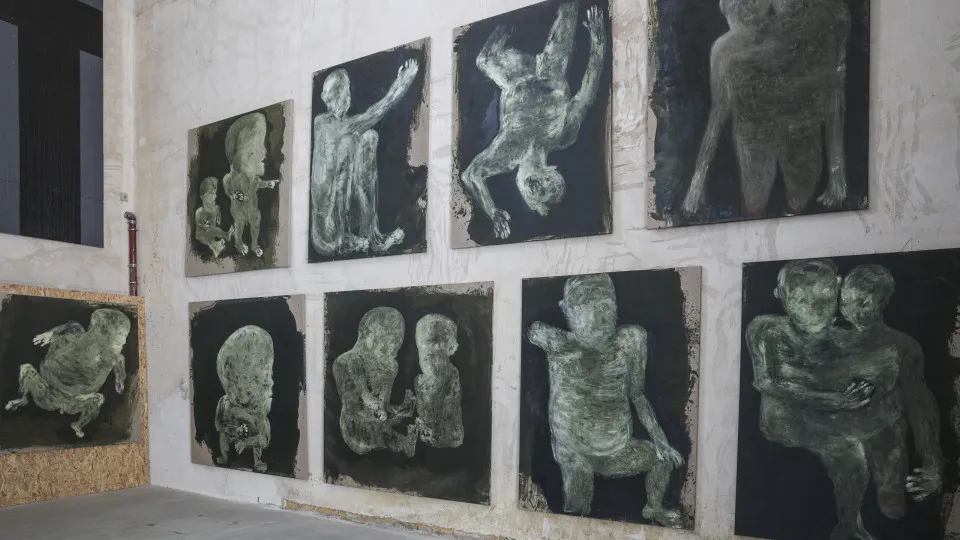Pedro Cabrita Reis shows over 1,500 works in exhibition
More than 1,500 works by Pedro Cabrita Reis make up 'Atelier', an exhibition composed solely of pieces from the artist's personal collection, which brings to eight pavilions of the Mitra, in Lisbon, the spirit of the "accumulated disorder" of an artistic studio.

© Lusa

Cultura Exposição
The Lusa agency visited 'Atelier' on Thursday morning, and Pedro Cabrita Reis, one of the most recognized Portuguese artists nationally and internationally, at the time revealed that he had decided to "do nothing more", but as someone who works "tirelessly", it is possible that he has created more works since then.
Among the oldest pieces on display are works on paper and oil and canvas paintings, dating back to when Pedro Cabrita Reis was still a teenager, and "already had absolute clarity" that he would be an artist, and that he would be "all his life".
The eight pavilions, where there is only natural light, can be visited as each visitor understands, since there is no chronological or thematic order of the placement of the pieces.
"The assembly criterion for this exhibition is certainly not an orthodox curatorial order criterion", said the artist, explaining that the works on display "come from different times, from different disciplines, tell different stories and are all side by side, ordered in a random way, but designed, in an unprecedented way, but designed, in a chaotic way, if you want to take this even further, but designed".
The place that each work occupies in space was based on a decision by the artist: "Whether or not this orange canvas, which is a landscape, should be shown with these self-portraits that are on its right", for example.
Pedro Cabrita Reis wanted to bring to the Mitra pavilions "the spirit of the atelier" of an artist, "a spirit that has an accumulated disorder".
"The exhibition is called 'Atelier' not only because it comes only from my personal collection, but also because there is an atmosphere of coexistence in the atelier. The works run into each other, push each other, talk to each other, some are turned towards the wall, others turned towards here, with sculptures on the floor", he said.
The works, which have no captions to contextualize them, were 'arranged', on the walls and on the floor, by "affinities of aesthetic order".
"They are the result of a relatively subjective plan and in the final stretch the adjustments are made. This was not assembled sequentially -- the first pavilion first, then the second, etc. It [exhibition] was born, grew, was built and developed in the same way in all the pavilions at the same time. Until the final days came when my team and I went through [all the pavilions] and took notes 'maybe move this next to that piece, like this, like this, tomb'. And that's how it was", he explained.
Although more than 1,500 pieces are on display in the exhibition, many others remained in the warehouse where Pedro Cabrita Reis keeps his personal collection.
"What is here is a large part, certainly more than two thirds, but I still have other works in the same warehouse where these came from", he said.
Some, "due to their size, did not fit" in the exhibition. "In other cases, my choices were made in another way -- I went to the warehouse several times to get works for this exhibition and some went back home", he said.
Pedro Cabrita Reis shared with Lusa that he works "tirelessly", he is "always working".
"I have that inner disposition. Even if it is not with my hands, the artist is always working. Looking around, signaling the things around, and seeing through them what they can give as a potential reason for the creation of a work, or for the deepening of any thought, in, of and for artistic creation", he shared.
Traveling among the thousands of works he had available to exhibit in the exhibition did not bring him any surprises, since he remembers almost everything he did.
"With my age [67 years old] and the bad life I have led since I started to have some personal life, my memory has been fading, but not the memory of work. The charm of seeing the works is not from the surprise. I know exactly what is inside that box and inside that wrapping, and when it is unwrapped and put here the charm is from the encounter of an old friend", he said.
After the exhibition ends -- it is open until July 28 -- the works will all return to the warehouse.
"I will not sell anything, that was missing", he assured, aware that "there will be no shortage of harassment in that sense".
In addition to deciding not to sell the works, Pedro Cabrita Reis chose not to charge tickets for the exhibition.
"I received public money, through the Lisbon City Council, which was granted to me by the Lisbon Tourism Association. I did not consider it ethically correct to receive money from taxpayers and make money selling tickets", he justified.
If he had decided to charge tickets, they would never cost less than ten or fifteen euros, he said. "But in a family of five people, 75 euros, which is nothing, is a lot for many families", he said.
'Atelier' can be visited from Thursday to Sunday, between 2:00 pm and 6:00 pm
Leia Também: Final da Eurovisão hoje na Suécia com conflito em Gaza a marcar edição (Versão portuguesa)
00.

Descarregue a nossa App gratuita.
Oitavo ano consecutivo Escolha do Consumidor para Imprensa Online e eleito o produto do ano 2024.
* Estudo da e Netsonda, nov. e dez. 2023 produtodoano- pt.com



